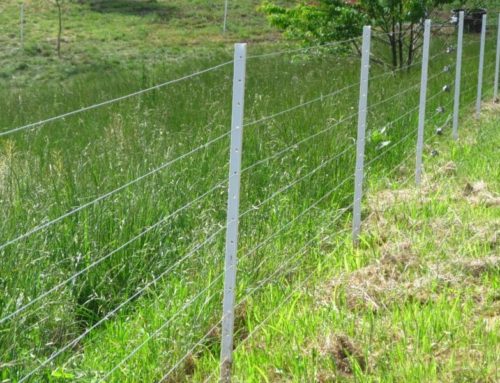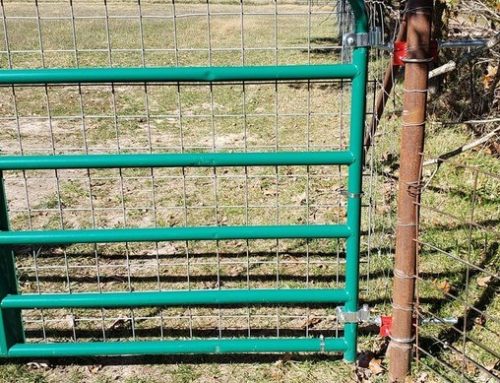
A look at how Great Plains farmers used barbed-wire fences to transmit telephone calls.
Barbed wire in the Great Plains did more than keep longhorn out. It also let Ma Bell in
Few inventions are as elegantly simple as barbed wire: a pair of wires twisted and strung with sharp wire thorns. After succeeding dramatically at its intended purpose–lowering the cost of fencing in the Great Plains so that farming and ranching could coexist–barbed wire unwittingly became part of the nation’s budding telephone network. What kept crops and animals apart helped bring people together.
Who invented barbed wire, like the question of who invented many influential technologies, was a matter of considerable debate among several inventors working along similar lines. Ultimately, the U.S. Patent Office and the courts upheld the claims of Joseph Farwell Glidden, a farmer from De Kalb, Ill., who had been granted patent 157,124 on November 24, 1874, for “a twisted fence wire having [a] transverse spur wire.” It soon became the most popular variety of fencing in the arid and semiarid region stretching west from the 98th meridian to the Rockies. Its use spread so rapidly, in fact, that sales climbed from 10,000 pounds in 1874 to nearly 13 million pounds in 1877, and reached a spectacular 80.5 million pounds in 1880. The ubiquitous fencing, in turn, became the infrastructure for an extensive web of “talking wires” connecting thousands of American farmers.
The story played out this way. Two years after Glidden was granted his barbed-wire patent, Alexander Graham Bell transmitted an electrical signal via a thin wire to an adjacent room. Like the telegraph interests in earlier decades, the major telephone companies–first Bell Telephone exclusively and then a host of phone companies after 1893 when the first of the Bell patents expired–focused on the urban business market. They considered the thinly populated rural market too unsophisticated for telephone service–and much too expensive to wire.
Then came a rural revolution. American farmers already had a long tradition of cooperative association. There were thousands of farmers’ cooperative insurance groups, grain elevators, and irrigation systems. By the turn of the century, farmers had come to see many uses for the telephone: dealing with emergencies, getting weather reports, pricing crops, recruiting labor, and even overcoming rural isolation. Not surprisingly, they started rural telephone cooperatives by the thousands. Their telephone “mutuals” were crude affairs. Each linked together a few, or a few dozen, farm households. Some used a switchboard, located in a store or more often in someone’s kitchen, while others operated as a community party line.
It was in building the network connecting homestead to homestead that the farmers’ ingenuity came to the fore. Instead of erecting new poles and wires, many either ran phone wires along the top of wooden fence posts or used the barbed wire itself to carry signals. The latter hardly worked as well as insulated copper wire, but with the lines already in place, installation and operating costs could be kept to a minimum. By one estimate, service ran a mere $3 to $18 a year, far less than the regional phone companies charged, and labor for maintaining the network was supplied by volunteers.
One such system operated in the isolated northeastern corner of Montana in the mid-1920s. Its developer was a farmer with “some electrical training,” who was called upon by neighbors to fashion a barbed-wire phone system. “There are miles and miles of pasture fences . . . and in many localities these corner each other at section junctions,” reported the farmer, who identified himself only as H.B.S. in the region’s farm journal.
The trickiest part of such installations was joining wires, whether between properties or across gaps in a farmer’s own fencing. Yet the system was supremely flexible. To bridge a gap between adjacent fences while allowing passage, one could employ several methods: bury insulated cable underground, or sink two tall poles into the earth and string them together with lead-covered insulated wire (the materials cost only $4), or even use barbed wire for the overhead crossing–as long as the splices were made with great care. (“Where the wires are looped, connect across a piece of wire and twist tightly on each side . . . and put more turns on than you think are necessary.”) Soldering, however, worked best.
Insulation was another challenge. Porcelain knobs worked well as insulators on fence posts to prevent the wires from short-circuiting in the rain. For the delicate business of bringing the wires into the home, farmers often threaded them through porcelain tubes. These were single-wire grounded systems–as H.B.S. noted, “the earth serving as the other circuit wire”–rather then the more expensive two-wire systems. To ensure that the circuit was properly connected with the earth, phone customers typically connected the end of the circuit to a six-foot galvanized pole that had been hammered into the ground. The farsighted H.B.S. even installed knife switches at regular intervals for circuit troubleshooting. These gave him the ability to shut down segments of the network to isolate faults on the line and thus locate them more quickly.
Though most of the nation prospered during the Roaring Twenties, American farmers suffered from a severe agricultural depression. (“Hard times like these force us to economize to the last cent,” reported the Montana system builder.) The eight members of the Montana East Line Telephone Association, therefore, were pleased that H.B.S. was able to get them connected for about $25 each. The package included a telephone set with two dry batteries and a “sure ring condenser,” a magneto, a lightning arrester, the ground rod, knobs, and tubes, plus 10 feet of interior wire and more than 50 feet of outside “drop wire” to connect with the nearest pole. “Beyond that,” explained H.B.S., “you may use any kind of wire you have.”
In this local network there was no regular service fee, though members of the cooperative paid a few dollars a year for routine maintenance and the cost of replacing the dry batteries (for which they sometimes substituted old car batteries). Thus, farm families in some of the cooperatives paid no regular telephone bills. Said H.B.S., “Ours are private property used for community service.”
More on Story https://www.inc.com/magazine/19970615/1416.html



